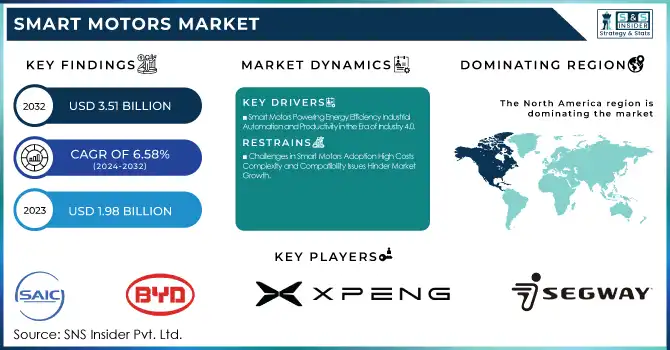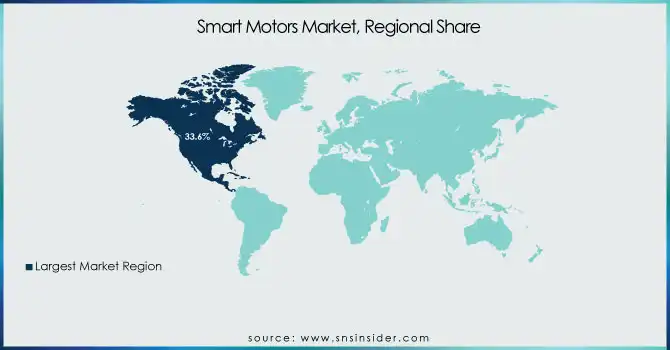Smart Motors Market Size & Growth:
The Smart Motors Market Size was valued at USD 2.11 billion in 2024 and is expected to grow at a CAGR of 6.58% to reach USD 3.51 billion by 2032. Intelligent Motors uses less power while producing efficient power, thus, energy savings and efficiency metrics are an essential part of the Smart Motors market, due to which end-users save operational costs and reduce environmental effects.

To get more information on Smart Motors Market - Request Free Sample Report
Their smart control systems raise the utilization rate by improving productivity and reducing downtimes through predictive maintenance. Rapid technological advancements have led to regular replacement/upgrade cycles in the market as industries continue to transition from traditional motors to smarter and more efficient alternatives. The channel distribution analysis highlights the increasing trend towards direct sales and online channels for sales and distribution owing to increased demand for customized solutions and reducing supply chain complexities across industrial automation and smart infrastructure solutions.
Market Size and Forecast:
-
Market Size in 2024 USD 2.11 Billion
-
Market Size by 2032 USD 3.51 Billion
-
CAGR of 6.58% From 2025 to 2032
-
Base Year 2024
-
Forecast Period 2025-2032
-
Historical Data 2021-2023
Smart Motors Market Trends:
-
Increasing adoption of energy-efficient smart motors to reduce operational costs and improve productivity.
-
Integration of smart motors with IoT platforms for real-time analytics and predictive maintenance.
-
Growing demand driven by smart manufacturing and Industry 4.0 practices.
-
Expansion of applications in HVAC systems, automotive, and consumer electronics.
-
Rising use of AI and machine learning in motor control systems for enhanced operational efficiency.
Smart Motors Market Growth Drivers:
-
Smart Motors Powering Energy Efficiency Industrial Automation and Productivity in the Era of Industry 4.0
The smart motors market has enjoyed several growth factors, the key among them being the resounding demand for energy-efficient systems, alongside industrial automation. As it provides accuracy in the control and monitoring of motor functions, industries are increasingly using smart motors for the improvement of productivity and to lower operational costs. Smart manufacturing and Industry 4.0 practices further drive demand for such motors since they can be integrated with IoT platforms leading to analytics and predictive maintenance in real time. Furthermore, rigorous international energy regulations are catalyzing the usage of smart motors, as these devices can provide considerable energy savings over traditional motors. Further growth in the market is supported by expanding applications in HVAC systems, automotive, and consumer electronics.
Smart Motors Market Restraints:
-
Challenges in Smart Motors Adoption High Costs Complexity and Compatibility Issues Hinder Market Growth
Factors restraining the growth of the smart motors market include the high capital cost involved with the installation and the complexity of the installation of smart motors. Smart motors still need advanced control systems and connectivity solutions, thus higher initial investment in comparison to traditional motors. A cost factor can be a hurdle for budget-conscious small and medium-sized enterprises. Also, a shortage of human resources who will not be able to operate or maintain such complex systems is a challenge, and without the required technical skills, the systems will not be widely adopted. Smart motors are usually incompatible with the infrastructure and legacy systems currently in use and as such this presents a barrier to their integration in older industrial setups.
Smart Motors Market Opportunities:
-
Smart Motors Market Opportunities Driven by Urbanization Smart Cities and AI-Powered Predictive Maintenance Solutions
The opportunities in the smart motors market are huge, especially in developing regions due to industrialization and urbanization. With increasing focus on smart cities and building automation systems, this has huge potential as smart motors are a part of intelligent infrastructure. Lastly, innovations in communication technologies including 5G are anticipated to provide better remote monitoring and control functionalities, thereby widening the applications of smart motors. The introduction of Artificial Intelligence and Machine Learning in Motor Control systems is expected to drive lucrative opportunities throughout the forecast period by providing operational efficiency and predictive maintenance solutions helping the market to grow tremendously in the coming years.
Smart Motors Market Segment Analysis:
By Product
The 24V segment accounted for the largest market share of 38.2% in 2024, generating revenue from applications such as industrial automation, automotive depending on the smart motors market, and consumer electronics, in the smart motors market. Due to its cost, safety, and efficiency, it is the most popular power electronics for low-power applications.
The 48V and above segment is anticipated to expand at the highest CAGR during (2025 - 2032) due to the rising requirement for high-efficiency and high-performance systems in electric vehicles, renewable energy systems, and sophisticated industrial automation. The boost is because of the increasing application of advanced electrification and energy-saving solutions all over the world.
By End Use
The industrial segment led the smart motors market, accounting for a 35.8% share in 2024, owing to rising automation and growing demand for energy-efficient systems across manufacturing, robotics, and processing industries. Due to the ability of smart motors to provide precision control and predictive maintenance, they improve productivity while lowering operational costs, a key factor that is expected to drive market growth for industrial applications over the forecast period.
The automotive segment is anticipated to register the most rapid CAGR over the 2025 to 2032 timeframe on account of surging demand for electric vehicle (EV) applications and advanced driver-assistance systems (ADAS). Along with the worldwide trends of persistent mobility inclined towards sustainability & vehicle electrification, it corroborates this growth.
Smart Motors Market Regional Analysis:
North America Smart Motors Market Insights
North America led the smart motors market with a 33.6% share in 2024, owing to the high adoption of automation technology and energy-efficient systems in manufacturing, automotive, and aerospace industries, among others. Well-established businesses such as Rockwell Automation and Honeywell foster the innovation and growth of the United States market, which ultimately increases demand for process instrumentation in the region. For instance, industrial automation solutions provider Rockwell Automation incorporates smart motor technology into its solutions to improve operational efficiency and predictive maintenance.
Asia Pacific Smart Motors Market Insights
The Asia Pacific region will witness the fastest CAGR from 2025 to 2032 due to rapid industrialization, urbanization, and the growing need for investment in smart manufacturing and electric vehicles. Leading countries include China, Japan, and South Korea with vertical linkage to the automotive and electronics industry. Japan's Nidec Corporation is another large supplier of smart motors for electric vehicles and home appliances. Asia Pacific is also another lucrative region for smart motor manufacturers due to increasing focus on energy efficiency, government initiatives supporting Industry 4.0, and increasing penetration of electric vehicles (EVs) in the region, thereby driving the market growth in this region.
Europe Smart Motors Market Insights
The Europe smart motors market is growing steadily, driven by strong demand for energy-efficient solutions and industrial automation. The industrial sector remains the key adopter, integrating smart motors for improved productivity and reduced costs. Smart manufacturing initiatives and supportive regulations across the region are fueling adoption. Countries with advanced manufacturing infrastructure are leading growth, while ongoing innovation in motor control and IoT integration continues to expand market opportunities.
Latin America (LATAM) and Middle East & Africa (MEA) Smart Motors Market Insights
The Latin America smart motors market is expanding due to rising industrial automation and a growing focus on energy efficiency. The industrial sector is the largest user, leveraging smart motors to improve operational performance. Urbanization and technological adoption in manufacturing and infrastructure projects are key growth drivers. Countries with emerging industrial bases are seeing increased investments, while advancements in predictive maintenance and IoT integration are opening new applications for smart motors.

Get Customized Report as per Your Business Requirement - Enquiry Now
Smart Motors Market Key Players:
Some of the Smart Motors Market Companies are
-
SAIC Motor (Smart Electric Vehicles, Intelligent Vehicle Platforms)
-
BYD (Sealion 7 Electric SUV, Yangwang U8 Hybrid SUV)
-
Xpeng (P7+ Electric Vehicle, Flying Car Prototype)
-
Segway (Xyber E-Bike, GT3 Pro Scooter)
-
Foxconn (Model B EV Hatchback, Automotive Batteries)
-
Ebm-papst (Electric Motors, Fans)
-
ABB (Azipod Electric Propulsion Systems, FlexPicker Robots)
-
Yaskawa Electric Corporation (Motoman Industrial Robots, Servo Drives)
-
Mabuchi Motor (Small Electric Motors for Automotive Applications, Motors for Consumer Electronics)
-
Tesla, Inc. (Induction Motors, Internal Permanent Magnet Motors)
-
Nidec (Small Precision Motors, Automotive Motors)
-
Huawei (Automotive Intelligent Systems, Electric Vehicle Components)
-
Bosch (Electric Drive Motors, Smart Actuators)
-
Siemens (Smart Motor Control Centers, Electric Propulsion Systems)
-
General Motors (Ultium Drive Motors, Electric Vehicle Platforms)
Competitive Landscape for Smart Motors Market:
SAIC Motor is a leading Chinese state-owned automotive manufacturer committed to advancing smart mobility. Through its brands, including IM Motors and MG, SAIC integrates advanced technologies such as AI, IoT, and full-stack software into its vehicles. Collaborations with partners like Huawei have led to the development of intelligent electric vehicles, enhancing user experience with features like autonomous driving and connected services. SAIC's focus on smart motors aligns with Industry 4.0, driving innovation in the automotive sector.
-
In February 2025, SAIC Motor and Huawei agreed to collaborate on developing advanced smart electric vehicles, aiming to boost competitiveness in the global EV market.
XPeng Motors is a leading Chinese electric vehicle manufacturer specializing in intelligent mobility solutions. The company integrates advanced smart motor systems with AI-driven software, IoT connectivity, and autonomous driving capabilities to enhance performance and energy efficiency. XPeng’s innovations, including the P7+ and flying car prototypes, position it at the forefront of Industry 4.0 automotive transformation. Its focus on smart motors supports sustainable, high-performance electric mobility.
-
In November 2024, XPENG Motors unveiled the P7+, touted as the world's first AI-defined vehicle, featuring advanced AI driving assistance and in-car experiences.
| Report Attributes | Details |
|---|---|
| Market Size in 2024 | USD 2.11 Billion |
| Market Size by 2032 | USD 3.51 Billion |
| CAGR | CAGR of 6.58% From 2025 to 2032 |
| Base Year | 2024 |
| Forecast Period | 2025-2032 |
| Historical Data | 2021-2023 |
| Report Scope & Coverage | Market Size, Segments Analysis, Competitive Landscape, Regional Analysis, DROC & SWOT Analysis, Forecast Outlook |
| Key Segments | • By Product (18V, 24V, 36V, 48V and above) • By End Use (Industrial, Automotive, Consumer Electronics, Aerospace & Defense, Other) |
| Regional Analysis/Coverage | North America (US, Canada), Europe (Germany, UK, France, Italy, Spain, Russia, Poland, Rest of Europe), Asia Pacific (China, India, Japan, South Korea, Australia, ASEAN Countries, Rest of Asia Pacific), Middle East & Africa (UAE, Saudi Arabia, Qatar, South Africa, Rest of Middle East & Africa), Latin America (Brazil, Argentina, Mexico, Colombia, Rest of Latin America). |
| Company Profiles | SAIC Motor, BYD, Xpeng, Segway, Foxconn, Ebm-papst, ABB, Yaskawa Electric Corporation, Mabuchi Motor, Tesla, Inc., Nidec, Huawei, Bosch, Siemens, General Motors. |

